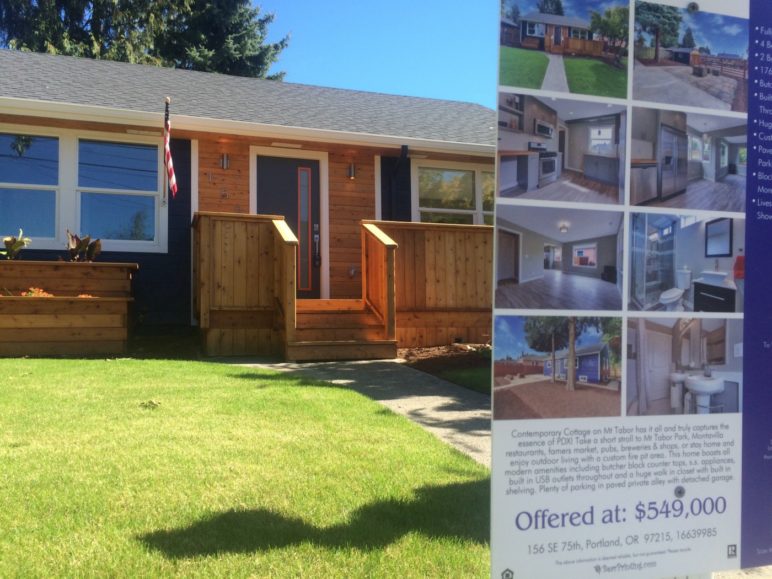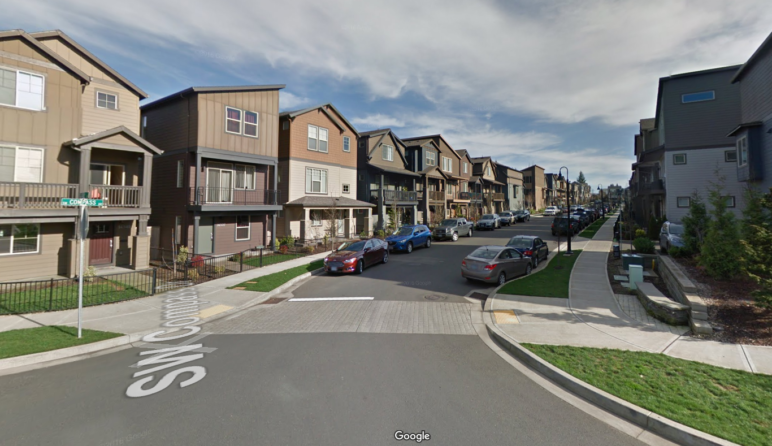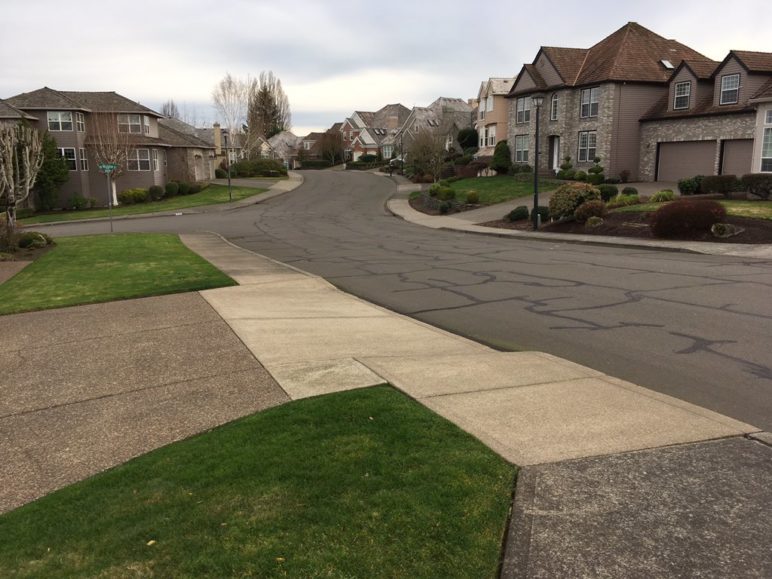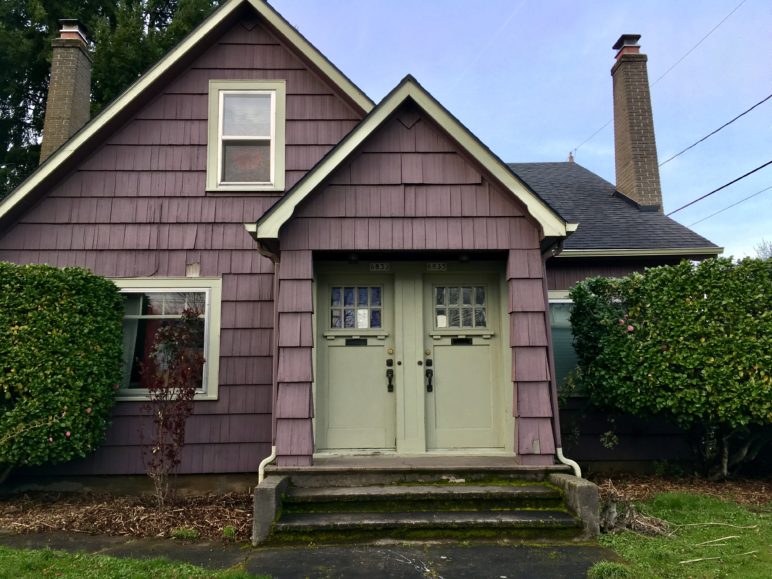In the month since news broke that Oregon’s legislature will consider a bill to strike down 60-year-old bans on “middle housing,” some battle lines have emerged.
The Oregonian‘s editorial board is for it; the Bend Bulletin‘s is against. Habitat for Humanity of Oregon is excited; the Oregon Republican Party’s Twitter account is dubious.
But another group of people has been enthusiastically discussing the proposal, House Bill 2001, which would re-legalize duplexes, triplexes, quads and cottage clusters in all neighborhoods of the state’s larger cities, towns and unincorporated suburbs. They’re a loose network of housing advocates who’ve spent 45 years immersed in the successes and failures of one of Oregon’s proudest legislative achievements: its first-in-the-nation statewide land-use planning law.
Championed and signed in 1973 by the liberal Republican Gov. Tom McCall, Senate Bill 100 (as its acolytes still call it, the way basketball fans remember Kareem Abdul-Jabbar’s jersey number) is best known today as an anti-sprawl measure. It created the “urban growth boundaries” that prevent endless strip-mall exurbs from hopscotching their way down the Willamette Valley or up the Rogue River.
But there was a different, extremely important effect of that law that few people remember today: In the 10 years after its passage, McCall’s bill forced Oregon’s cities to zone for much denser housing. In the Portland metro area, housing capacity doubled in four years. The remarkably compact Portland region we know today is the result.
Senate Bill 100 didn’t just limit Oregon’s urban sprawl. It was also the most important state-led upzone in the history of Cascadia, and maybe also of the United States.
To understand the importance of this year’s HB 2001, you have to know a little bit about the ways SB 100, since 1973, both has and hasn’t worked.
Oregon started rethinking zoning just as people were discussing its role in segregation

Oregon first attempted state-level zoning reform 50 years ago this spring, in March 1969, when it became the first US state to require that all its land be zoned as part of comprehensive plans.
Zoning wasn’t a new idea. By 1969, it had been growing in popularity for 50 years. In Oregon, the most exclusive neighborhoods of Portland—Laurelhurst, Irvington, the West Hills—had been among the first to embrace laws that set a minimum yard size for every home within a certain area. The rules weren’t always written with hostile intent. But one effect was to block low-wealth families, including most immigrants and most descendents of enslaved people, from buying into those neighborhoods.
And by the late 1960s, this side effect of banning attached homes from much of the city—the fact that such bans seemed to lead inexorably to deep segregation by wealth and race, and thereby transmit prejudice and disadvantage from generation to generation—was a major topic of national legislation and debate.
In April 1969, UCLA law professor Lawrence Sager helped popularize a new term for this phenomenon: “exclusionary zoning.”
Banning small and mid-sized homes from an area “strongly reinforces the social propensity to form tight little islands of residential exclusivity,” Sager wrote at the time. “Exclusionary zoning may bar not only the poor or near poor, but a fairly substantial segment of the middle class as well.”
A few months later, in Connecticut, a young journalist named Al Johnson chose a harsher phrase in a newspaper editorial: “American apartheid.”
“Town after town has decided that low-income housing will have to be someone else’s responsibility,” he wrote. “The result of this widespread refusal to accept responsibility has been the exclusion of low-income groups from town after town.”
“The new planner,” a 1969 article in the professional magazine Planning declared, sees “exclusionary practices in zoning and subdivision control as serving to contain less-favored population in the central city slums [and] relates the lily white (or token integrated) suburban school system to the desperate problem of maintaining racial balance in the central city’s schools.”
This was the world into which Oregon’s state-level land-use planning regime was born.
Oregon’s statewide zoning law introduced an idea: Requiring every city to make room for people of every income

Despite this national conversation, Senate Bill 100—the 1973 law intended to add teeth to Oregon’s 1969 zoning mandate—nearly failed to force local zoning to allow more diversity of housing.
The fact that it ultimately did was thanks in large part to a woman named Betty Niven, a Eugene-based advocate for housing people of low and moderate wealth. A volunteer member of the Eugene Planning Commission and later the chair of the State Housing Council, Niven (who held a degree in business from the University of Chicago) became nationally known for a “groundbreaking” 1980 report showing that mobile home parks were not a financial burden on local governments.
As recounted by two Portland State University historians in a 2010 paper, Niven had by then already been a key force behind Oregon’s decision to include, among the regulations the state put on local zoning plans, this crucial clause:
Plans shall encourage the availability of adequate numbers of housing units at price ranges and rent levels which are commensurate with the financial capabilities of Oregon households and allow for flexibility of housing location, type and density.
Those words became known as Oregon’s “housing goal,” also called “Goal 10.” They meant the state was forbidding its cities and counties from using zoning to permanently wall themselves off from poor or middle-income people who might want to live there.
In a memo supporting the housing goal, Niven explained her motivation: “to ensure that fulfilling the other goals of the statewide land use plan will not unreasonably impact the supply of modestly priced housing.”
Niven had perfectly anticipated the debate that would dominate the next half-century of Oregon housing politics: whether an urban growth boundary in a growing region drives up housing costs. And she’d also arrived at an answer: no, it doesn’t have to—but only if every community keeps adjusting its zoning code to let all sorts of people live in it if they want to.
Oregon’s suburbs allow more homes than many suburbs do—because they were required to

The moment Oregon attempted to ban exclusionary zoning, jurisdictions started looking for ways to get around it.
Among them:
- Durham, a tiny city in Portland’s comfortable southwest suburbs, which in 1977 tried to double its minimum lot size in order to (in the quoted words of the planning director and city council member John Sattler) discourage “transient” residents.
- Multnomah County, which in 1980 passed a law allowing new mobile home parks but creating what regional government Metro called “vague and discretionary criteria that allow for their exclusion.”
- King City, required by Metro in 1997 to legalize small accessory cottages on all residential lots. The city legalized them only on lots of at least 7,500 square feet—of which King City has almost none.
- The City of Lake Oswego, a well-off suburb of 38,000. Its land is dedicated overwhelmingly to large lots and freestanding homes, but as of 2013 the city claims to be in compliance with a state mandate to allow half its future homes to be “attached.” The city’s excuse: It’s given every owner of a one-unit lot the option to build all the way to the edge of their land, technically legalizing duplexes … while ensuring that duplex homes would cost just as much as detached ones.
So, starting in the 1970s, Oregon recruited a team of regulators to enforce its new land-use laws: the cats to local jurisdictions’ mice.
One of them turned out to be Al Johnson, the former journalist who’d written the “American apartheid” editorial years before. Inspired by his reporting on Connecticut’s exclusionary zoning, Johnson had gone to law school; now, as an administrative hearing officer, he was helping enforce one of the nation’s most ambitious state laws against economic segregation.
“The housing goal clearly says that municipalities are not going to be able to do what they have done in metropolitan areas in the rest of the country,” Johnson wrote in his opinion for Seaman v. Durham, a landmark administrative-law decision that rejected Durham’s 1977 rezoning and set the tone for Oregon zoning politics in the late 70s. “They are not going to be able to pass the housing buck to their neighbors on the assumption that some other community will open wide its doors and take in the teachers, police, firemen, clerks, secretaries and other ordinary folk who can’t afford homes in the towns where they work.”
Empowered by decisions like that one, Johnson and his peers eventually established specific mandates for the Portland metro area, requiring each of the area’s significant cities to allow certain numbers of homes per acre.
It was that rule, backed up by legal action from the anti-sprawl group 1000 Friends of Oregon, that achieved what Johnson called a “very, very significant reduction in average lot sizes” across the suburbs between 1978 and 1982—the state-led upzone that doubled the metro area’s housing capacity in an era when some other metros were rapidly downzoning.
“Right from the beginning, the proponents of the housing goal knew there was a problem of local control over residential zoning,” said Robert Liberty, who joined 1000 Friends as a staff attorney in 1981 and later led the organization from 1994 to 2002 before serving as a three-term Metro councilor. “That is why they wrote Goal 10 to try to break exclusionary zoning. We made great strides in the 1980s and 1990s. But progress has stalled.”
Oregon doesn’t enforce its state housing laws like it used to

Many people share Liberty’s opinion: Oregon has grown much less ambitious in the last 20 years about requiring exclusively wealthy, overwhelmingly white areas to allow more diversity.
They say that’s the case both at the state’s Land Conservation and Development Commission and at Metro, the Portland-area regional government.
“Goal 10 supports really effective land use planning for housing,” said Lisa Bates, a planning professor at Portland State University who studies housing choices and displacement. “But it hasn’t yet required really effective land use planning for housing, because the enforcement of it has been limited.”
“I don’t know that the commitment to enforcing Goal 10 is strong enough at the state, regional level, however you want to slice it,” said Allan Lazo, executive director of the Fair Housing Council of Oregon, which works against segregation and housing discrimination.
“LCDC doesn’t have any guts,” said Ed Sullivan, a former 1000 Friends attorney and co-founder of Housing Land Advocates, a group that opposes exclusionary zoning in Oregon.
Johnson, the former state hearing officer, said Oregon cities have tried to meet density requirements mostly by concentrating major growth along big streets rather than letting small attached homes fill gently into well-off low-density areas.
“Metro, very early on as part of a sop to the various jurisdictions, basically said, ‘We’re not going to have any impact on your existing neighborhoods,'” Johnson said. “‘Single-family neighborhoods can continue to be sanctuaries; we’re going to string these housing types all along the transit corridors and collectors and arterials and places like that.’”
Mary Kyle McCurdy, deputy director for 1000 Friends, said she doubts any city in Oregon could show that it has built enough “middle housing” types to meet demand.
“If your choice is to live in a six-story apartment … or a single-family structure, you’re just not meeting the needs of all,” she said.
HB 2001 would likely be the Oregon legislature’s strongest action against economic segregation in 35 years

Bates, the displacement and housing choice scholar, called HB 2001, the middle-housing re-legalization proposed by Oregon House Speaker Tina Kotek, “great.”
Zones that ban attached housing “create and maintain class and race segregation to the benefit of (almost always) white homeowners,” Bates said. “Localities are very averse to changing this pattern of housing, even when it demonstrably causes not only social inequality but also economic inefficiencies and environmental harms.”
Lazo, the fair housing advocate, said a mere legalization bill couldn’t, on its own, fix centuries of racism in housing. And he emphasized the need for more Oregonians of color to weigh in directly on the specifics of HB 2001.
But he also said it’d be good to strike down the concept that buildings shared by more than one family are somehow inherently incompatible with certain neighborhoods in Oregon.
“It’s part of the institutionalization of segregation,” Lazo said. “The reason single-family zoning came into play in the early part of the 20th century was to exclude people of different races, different income levels. … I’ve lived in this community for a long time, and that’s not who I think we are. And I don’t think continuing to maintain that system reflects these values.”
Juan Carlos González, a newly-elected Metro councilor from Portland’s western suburbs, said his support for more “workforce housing” options like duplexes, triplexes and quads was rooted first in their general benefits to the economy and environment.
But, he added, “Any strategy like this needs to have a racial equity component. Re-grounding the conversation on the history of zoning … I think it’s a big part of economic justice.”
Quoting US Rep. Alexandria Ocasio-Cortez, González said removing bans on middle housing was a way to fight the “ZIP-code destiny” that perpetuates economic inequality.
Liberty, the former 1000 Friends director and Metro councilor, said strong legislative action against exclusionary zoning—as written, Kotek’s bill would likely be the strongest since the early 1980s—would renew state regulators’ sense that their own, related work is part of a noble and important tradition.
“I think that’s just what happens over time: a loss of a sense of mission,” Liberty said.
“A sense of mission”—if someone can learn anything from a few weeks reading and talking to people who steered Oregon housing policy through the 1970s and 1980s, it’s how powerful their sense of mission remains, deeply imprinted 40 years later. If it hadn’t been so strong, it’s hard to imagine McCall’s quixotic land-use law would have turned out nearly so well.
And if someone can learn two things, it’s that the battle lines through this debate were already drawn long, long ago. For Oregonians and others who care about these issues, the most pressing question isn’t whether a new battle is coming. It’s which side you’re going to be on.


Comments are closed.